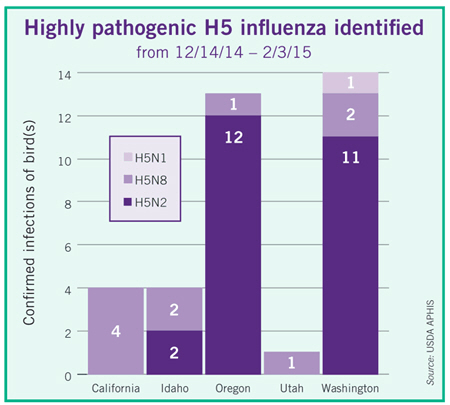



Update on Avian Influenza in Western US States
US - An overview of the avian influenza viruses found in Northwestern states from the national veterinary organisation, which includes a warning to backyard flock owners to be on the alert for signs of disease in their poultry.Highly pathogenic strains of avian influenza virus, including one that killed turkeys in California, have been found in five Northwestern states since mid-December 2014.
No people are known to have become sick in connection with the avian influenza viruses. The Centers for Disease Control and Prevention is taking a cautious approach until more is known about the viruses, and its recommendations are consistent with guidance for influenza viruses associated with severe disease in humans, according to a Morbidity and Mortality Weekly Report distributed on 3 February.
Those recommendations are available as part of the guidance from the Centers for Disease Control and Prevention (CDC).
In an overview for the Amercian Veterinary Medical Association (AVMA), Greg Cima writes that strains of highly pathogenic H5 influenza virus had been identified in wild and captive birds 36 times in five states by early February. Of these incidents, 25 were in wild birds, seven in backyard flocks, three in captive raptors, and one in a commercial turkey farm.

Source: USDA APHIS
An H5N8 influenza virus outbreak that started in December 2014 killed about 4,500 turkeys out of a 145,000-bird flock in Stanislaus County, which is south of Sacramento, according to a report from the World Animal Health Organisation (OIE). The Department of Agriculture’s Animal and Plant Health Inspection Service announced on 24 January that the agency had confirmed the virus was present.
APHIS information indicates state agriculture officials implemented a quarantine on the farm and that APHIS and state authorities would depopulate the remaining birds to prevent spread of the disease.
By early February, infections with highly pathogenic H5N2, H5N8, and H5N1 influenza viruses of Asian lineage had been found 36 times: 25 times in wild aquatic birds, seven in backyard bird flocks, three in captive raptors, and once in a commercial farm, according to information from APHIS and the CDC. Those infections were in California, Idaho, Oregon, Utah and Washington.
Dr Annette Jones, California’s state veterinarian, said in late January that the turkey farm outbreak remained limited to one location, which was fairly isolated even though other poultry farms are in the same county.
The birds are kept indoors but the farm is in a flyway used by migratory waterfowl.
Epidemiologists were just starting to look into how the virus spread to the turkeys, she said.
Dr Jones noted that avian influenza viruses can affect backyard birds and she advised that small animal veterinarians educate clients who own such animals about clinical signs of influenza infection.
Information from APHIS indicates an H5N1 influenza virus found in Washington state is a different strain from that associated with illnesses in Asia and Africa, and it is not expected to be a human health risk. The virus was found in an American green-winged teal, confirmed by testing on 16 January.
Hector Castro, spokesman for the Washington State Department of Agriculture, said the H5N1 virus was discovered in Whatcom County along the Canadian border, where highly pathogenic H5N8 and H5N2 influenza viruses also have been found. His department’s response has included warning poultry owners to be aware of the highly pathogenic influenza viruses present in wild birds.
Mr Castro said this year was the first in which such highly pathogenic influenza viruses have been found in Washington, despite a large population of wild birds that migrate through the state.











